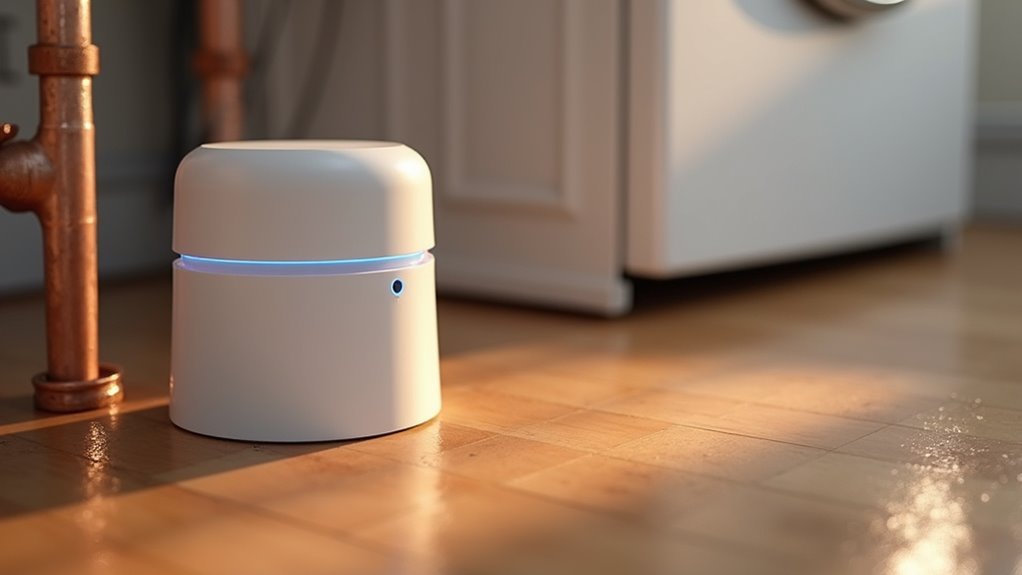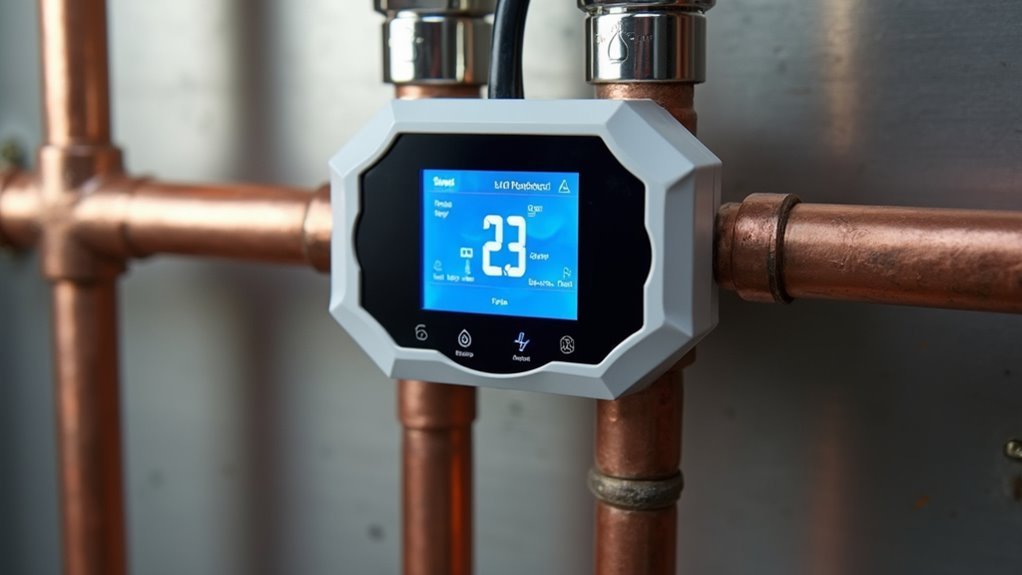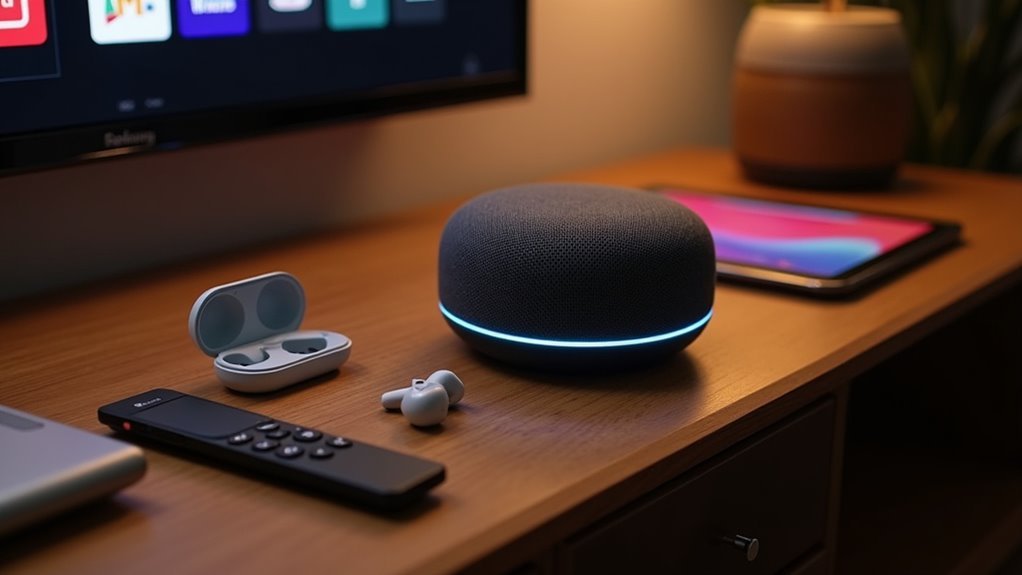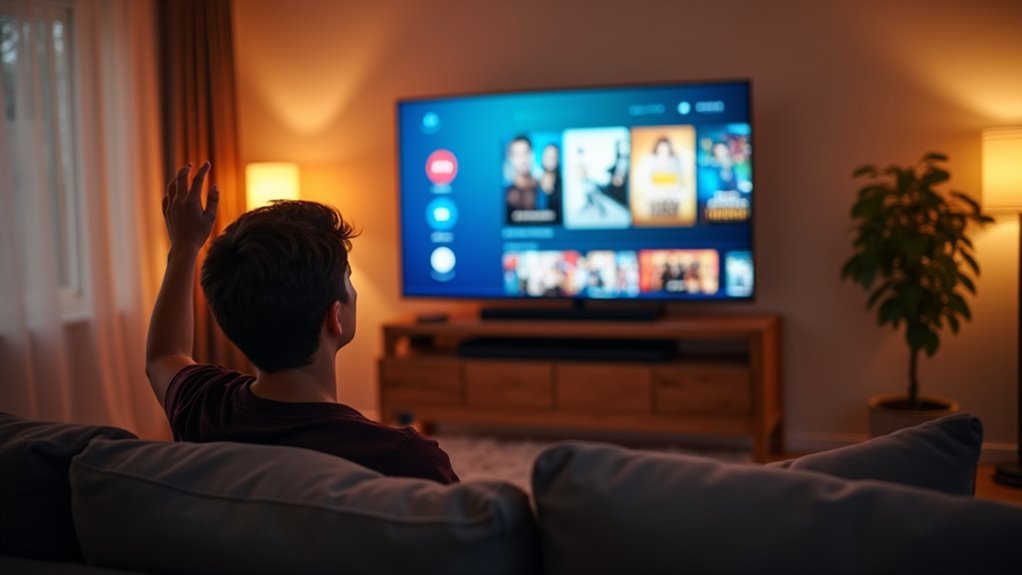You’re probably aware that water damage costs homeowners billions annually, but you might not realize how advanced prevention technology has become. Smart leak detectors, freeze monitors, and automatic shut-off valves now work together to create an early warning system that can save you thousands in repairs. The question isn’t whether you need water protection devices—it’s which combination will give you the most extensive coverage for your specific home.
How Smart Leak and Freeze Detectors Work

Smart leak and freeze detectors serve as your home’s early warning system, continuously monitoring for moisture, temperature drops, and unusual water flow patterns.
These smart leak detectors use sensors to identify potential problems before they escalate into costly disasters. When triggered, they immediately send alerts through smartphone notifications or in-home audio systems, keeping you informed whether you’re home or away.
Smart sensors catch problems early, instantly alerting you via phone or home audio before minor issues become expensive disasters.
You can choose between battery-powered units or plug-in models with battery backup, ensuring protection even during power outages.
Most devices connect to your home’s Wi-Fi network, enabling real-time monitoring and instant alerts. Advanced models include automatic shut-off valves that immediately stop water flow when leaks are detected, providing an additional layer of protection for your property.
Cost Range of Smart Home Water Detection Systems
You’ll find smart water detection systems span a wide price range, from basic leak sensors under $50 to extensive monitoring systems costing $850 or more.
Simple battery-powered detectors typically run $30-$100, while advanced monitors with real-time tracking capabilities cost around $199-$499.
You’ll also need to factor in potential installation fees, especially for whole-home systems that may require professional setup.
Basic Sensor Pricing
When shopping for smart home water detection systems, you’ll find prices span a wide range depending on the features and complexity you need.
Basic battery-powered leak detectors represent the most budget-friendly entry point into smart water protection. These simple sensors start around $20 to $50 per unit and can be strategically placed in high-risk areas throughout your home.
For minimal investment, you’ll get essential leak detection capabilities that alert you when moisture is detected. While these basic water monitors lack advanced connectivity features, they provide reliable protection for specific locations like under sinks, near water heaters, or around washing machines.
- Battery-powered sensors offer wireless placement flexibility without installation requirements
- Individual units cost $20-$50, making them affordable for multiple room coverage
- Simple operation provides essential leak detection without complex setup procedures
Advanced System Costs
Advanced water detection systems command considerably higher prices but deliver extensive protection through sophisticated monitoring capabilities.
You’ll find thorough leak detection solutions ranging from $325 to $575, with premium models like the Phyn Plus reaching $850. These advanced systems include water flow monitoring, automatic shut-off valves, and real-time alerts that basic sensors can’t provide.
The Flo system costs $499 and requires professional plumber installation, while the Streamlabs Smart Home Water Monitor offers monitoring features for $199 without needing plumbing skills.
You’re investing in integrated solutions that can automatically shut off your home’s water supply when problems occur, potentially saving thousands in water damage repairs.
Professional installation typically adds $100-300 to your total investment.
Installation Fee Considerations
While device costs represent a significant portion of your budget, installation fees can substantially impact your total investment in smart home water detection systems.
Professional installation requirements vary dramatically between models, with some systems adding $100 to $500 to your total cost.
Many smart leak detectors offer self-installation options, allowing you to save on labor expenses. However, extensive systems with automatic shut-off valves typically require professional plumbing services due to their complexity.
- Simple leak detectors like StreamLabs don’t require professional installation, saving you money.
- Advanced systems like Flo and Phyn Plus need plumber installation due to integrated features.
- Installation fees depend on system complexity and integration requirements.
Consider both upfront device costs and potential installation fees when budgeting for extensive water damage protection.
Point-of-Leak Sensors for Targeted Monitoring
You can deploy point-of-leak sensors in strategic locations around your home to create a targeted monitoring network that focuses on high-risk areas like appliances and plumbing fixtures.
These compact devices provide real-time leak detection by immediately sensing water presence and triggering alerts before minor leaks become major problems.
When water’s detected, you’ll receive instant smartphone notifications that allow you to respond quickly, even when you’re away from home.
Strategic Sensor Placement
Because water damage often occurs in predictable locations, point-of-leak sensors offer a targeted defense strategy that focuses protection where you need it most.
These compact, battery-operated devices should be positioned near washing machines, dishwashers, water heaters, and under sinks where leaks commonly develop. When strategically placed throughout your home’s high-risk areas, these sensors create a thorough detection network that dramatically reduces the chance of undetected water damage.
Key placement considerations include:
- Appliance proximity – Position sensors directly beneath or adjacent to water-using appliances for immediate detection
- Floor-level positioning – Place devices where water naturally flows and pools during leaks
- Smart home systems integration – Connect sensors to your existing network for centralized monitoring and smartphone alerts
Regular testing guarantees your sensors remain functional and responsive to even minor water presence.
Real-Time Leak Detection
Within seconds of detecting moisture, point-of-leak sensors transform from silent guardians into active alarm systems that can save your home from catastrophic water damage.
These compact devices instantly send smartphone notifications or trigger in-home alarms the moment they detect even minor water leak activity near washing machines, dishwashers, and other high-risk appliances.
You’ll receive immediate alerts whether you’re at home or away, thanks to smart home integration capabilities.
This real-time monitoring lets you respond quickly before a small drip becomes a costly flood.
Advanced leak sensors can even automatically shut off your water supply remotely, providing an extra layer of protection.
Smartphone Alert Systems
Three key smartphone alert features make point-of-leak sensors indispensable for targeted water monitoring throughout your home.
These compact devices strategically position near high-risk plumbing fixtures and appliances, sending immediate alerts to your smartphone when moisture gets detected. You’ll receive timely notifications that enable prompt action, preventing extensive damage while you’re away.
- Instant mobile notifications – Get real-time alerts to your smartphone the moment sensors detect moisture
- Smart home water integration – Connect multiple sensors through centralized apps for unified monitoring
- Battery-powered simplicity – Install devices without professional plumbing work or complex wiring
Many models integrate seamlessly with existing smart home water systems, allowing centralized control through single smartphone apps.
This targeted monitoring approach greatly reduces undetected leak risks, providing peace of mind whether you’re home or traveling.
Smart Whole-House Water Monitors
When you’re looking for thorough leak detection without installing multiple sensors throughout your home, smart whole-house water monitors offer an elegant solution.
These smart devices install in a single location and measure your overall water usage to detect leaks through consumption pattern analysis.
Smart whole-house monitors use single-point installation and consumption analysis to identify leaks throughout your entire home system.
After a 10-14 day learning period, the monitor establishes your household’s normal usage trends. It’ll then identify irregularities that could signal potential leaks, from the smallest drips to major issues.
You’ll receive real-time alerts through a smartphone app, enabling immediate action when problems arise.
Most models are designed for easy self-installation and integrate seamlessly with existing smart home ecosystems.
Smart Auto-Shutoff Devices and Valves

Smart auto-shutoff devices take water protection a crucial step further by automatically cutting off your home’s water supply when they detect irregularities.
Installed at your main water valve, these devices prevent small leaks from becoming catastrophic damage that averages $2,566 in repairs.
You’ll gain remote control through smartphone apps, allowing you to manage your water supply from anywhere.
Many smart auto-shutoff valves integrate seamlessly with leak detection systems, providing immediate alerts and automatic responses when problems arise.
Key benefits include:
- Instant protection – Automatic shut-off prevents minor leaks from escalating
- Remote management – Control your water supply via smartphone apps
- Comprehensive monitoring – Works alongside your water monitor for complete coverage
These devices offer peace of mind through proactive water damage prevention.
Wireless Leak Detection Networks
You’ll want to position multiple wireless leak detectors throughout your home to create a thorough monitoring network that covers all potential leak sources.
These sensors communicate with each other and your smartphone using Wi-Fi or other wireless protocols, ensuring you’re instantly notified when water’s detected anywhere in the system.
Setting up this multi-sensor approach means you’re not relying on a single point of detection, giving you complete coverage from your basement to your attic.
Multi-Sensor Network Setup
While individual leak detectors offer valuable protection for single areas, multi-sensor wireless networks provide extensive coverage that transforms your entire home into a smart water monitoring system.
You’ll position water sensors throughout high-risk zones like bathrooms, kitchens, basements, and near appliances. These multi-sensor networks communicate through Wi-Fi, sending instant alerts to your smartphone when moisture’s detected.
Advanced systems integrate with your smart home setup, automatically shutting off water supply when leaks occur. You’ll benefit from continuous monitoring since sensors run on batteries with backup power during outages.
- Strategic placement – Install sensors near water heaters, washing machines, dishwashers, and under sinks
- Real-time monitoring – Receive immediate notifications allowing quick response to prevent extensive damage
- Usage tracking – Monitor water flow patterns to identify potential problems before they become costly repairs
Wireless Communication Protocols
Because wireless leak detection networks rely on robust communication protocols, understanding the differences between Wi-Fi, Zigbee, and Z-Wave becomes essential for choosing the right system for your home.
Wi-Fi offers high-speed data transmission and direct internet connectivity, enabling instant smart alerts through smartphone apps.
Zigbee creates mesh networks that extend signal range while consuming minimal power.
Z-Wave provides reliable communication with strong encryption and interference resistance.
These protocols eliminate extensive wiring requirements, making installation straightforward and sensor placement flexible.
You’ll receive real-time alerts regardless of your location when leaks occur.
Multiple detectors communicate seamlessly across your property, ensuring thorough coverage.
The wireless design integrates with existing home automation platforms, enhancing your overall security system’s efficiency and control capabilities.
Smart Water Flow and Pressure Monitors

Smart water flow and pressure monitors function as your home’s intelligent guardians, continuously tracking water usage patterns and detecting anomalies that could signal costly leaks or impending damage.
These devices spend 10-14 days learning your household’s normal consumption habits before alerting you to irregularities. Once connected to your Wi-Fi network, they’ll send real-time notifications directly to your smartphone when something’s amiss.
Advanced models integrate seamlessly with smart water flow systems, automatically activating a shut-off valve when leaks are detected. This immediate response prevents extensive flooding and structural damage.
- Learning capabilities: Establishes baseline water usage patterns over two weeks
- Remote monitoring: Wi-Fi connectivity enables smartphone alerts and real-time data access
- Automatic protection: Integration with shut-off valves stops water flow during emergencies
You’ll also notice reduced water bills as these monitors identify hidden leaks and inefficient usage throughout your home.
Temperature-Based Freeze Detection Systems
You can protect your home from frozen pipes with temperature-based freeze detection systems that monitor critical areas like basements and attics.
These smart devices use freeze sensor technology to send real-time alerts to your smartphone when temperatures drop to dangerous levels.
Most systems integrate with automatic shut-off valves, giving you instant pipe protection by cutting off water flow before costly damage occurs.
Freeze Sensor Technology
When temperatures drop dangerously low, freeze sensors act as your home’s early warning system against potential pipe disasters. These smart devices monitor temperature fluctuations in vulnerable areas like basements, attics, and near plumbing fixtures.
When they detect freezing conditions, they’ll instantly send smartphone notifications or trigger in-home alarms, giving you time to take preventive action.
Modern freeze sensors integrate seamlessly with smart home systems, communicating with devices like automatic water shut-off valves. They’re designed to detect a leak before it becomes catastrophic damage.
Most models offer flexible power options, including battery operation with backup systems for continuous monitoring during outages.
- Strategic placement in high-risk areas maximizes protection coverage
- Real-time alerts enable immediate response to prevent burst pipes
- Smart integration automates protective responses throughout your home
Temperature Alert Systems
Temperature alert systems take home protection a step further by focusing specifically on the thermal conditions that lead to frozen pipes.
These devices monitor your indoor temperatures continuously and send immediate smartphone notifications or trigger in-home alarms when temperatures drop below your preset threshold. You’ll receive early warnings before freezing conditions can cause pipes to burst and prevent water damage throughout your home.
Advanced models integrate seamlessly with smart home systems, automatically activating heat sources or shutting off water supplies when dangerous conditions arise.
Since these temperature alert systems can operate on battery power with backup capabilities, they’ll keep working even during power outages.
This proactive approach helps you avoid costly repairs that typically average $2,566 according to industry data.
Automatic Pipe Protection
While temperature alert systems provide valuable early warnings, automatic pipe protection systems deliver thorough defense by combining continuous monitoring with immediate protective action.
These advanced systems use temperature-based freeze detection to monitor environmental conditions around your pipes, ensuring they don’t freeze and burst during extreme cold.
When critical temperatures are detected, you’ll receive instant smartphone notifications. More importantly, many systems integrate with smart water shut-off valves for automatic shut-off of your main water supply, preventing catastrophic water damage before it starts.
- Advanced models use machine learning to adapt to your specific plumbing system for enhanced accuracy
- Systems can detect a leak and respond faster than humanly possible
- Installation greatly reduces frozen pipe damage risks, potentially saving thousands in repair costs
Battery-Powered vs. Plug-in Detection Options
Choosing between battery-powered and plug-in leak detectors depends on your specific needs and home layout.
Battery-powered models offer exceptional flexibility since you can place them anywhere without worrying about electrical outlets. They’re compact and discreet, fitting easily in tight spaces around plumbing fixtures where leaks commonly occur.
Plug-in detectors provide continuous power and often include battery backup for power outages. These devices typically offer advanced features like real-time monitoring and smart home integration, but you’ll need them near power sources.
Both types send smartphone notifications and sound alarms when detecting water.
However, battery-powered options require regular battery replacements to maintain functionality, while plug-in models eliminate this maintenance concern through consistent electrical power.
Wi-Fi Connected Alert Systems
When you’re away from home, Wi-Fi connected alert systems transform your smartphone into a powerful water damage prevention tool. These systems send immediate notifications when moisture-sensitive sensors detect a leak near plumbing fixtures and appliances, catching problems in their earliest stages.
Advanced Wi-Fi connected alert systems offer remarkable protection through:
- Automatic shut-off capabilities that remotely stop your main water supply when leaks are detected
- Smart home integration that connects with existing automation systems for thorough monitoring
- Real-time water flow and pressure monitoring that identifies irregularities before they become disasters
You’ll find options ranging from simple battery-powered sensors to thorough monitoring systems. The investment varies considerably based on features and installation requirements, but the protection against extensive water damage makes these systems invaluable for proactive homeowners.
Professional vs. DIY Installation Requirements
After selecting your preferred Wi-Fi connected alert system, you’ll need to determine whether you can handle the installation yourself or require professional assistance.
Many smart water leak detection devices like the StreamLabs Monitor offer straightforward DIY installation—you’ll simply wrap the device around your water intake pipe without any plumbing modifications.
However, advanced systems such as Flo and Phyn Plus require professional installation due to their complex plumbing integration, which may involve cutting pipes or extensive modifications.
Battery-operated point-of-leak sensors are typically the easiest for DIY installation, as you’ll just place them in high-risk areas without any plumbing work.
Consider the installation complexity when choosing your device, since both professionally installed and DIY systems offer remote monitoring capabilities.
Integration With Existing Smart Home Systems
Beyond standalone water monitoring, today’s smart leak detectors can seamlessly connect with your existing smart home ecosystem to create an extensive protection network.
Smart water monitoring systems like StreamLabs integrate with Amazon Alexa and Google Assistant, letting you control everything through voice commands or a single app interface.
When connected to your smart home hub, these devices can automatically shut off your water supply and trigger other protective responses like disabling your HVAC system during emergencies.
Your home’s Wi-Fi network enables real-time alerts sent directly to your smartphone, while integration with security systems guarantees monitoring services receive immediate notifications.
- Voice control through popular assistants streamlines water management
- Automated shutoffs prevent extensive damage during leaks
- Centralized app control simplifies monitoring multiple devices
Water Usage Monitoring and Analytics Features
While smartphones revolutionized how you communicate, smart water monitors transform how you understand your home’s water consumption through detailed analytics and real-time insights.
These devices track your water flow patterns continuously, establishing baseline usage during a 10-14 day learning period. Advanced systems like the Flo monitor use machine learning to analyze flow rates, pressure, and temperature simultaneously, enabling them to detect a leak or inefficiency quickly.
You’ll receive detailed reports and instant notifications through smartphone apps when unusual spikes occur. This real-time monitoring helps you make informed decisions about water usage and maintenance.
Insurance Benefits of Installing Smart Water Protection
Installing smart water protection systems delivers benefits that extend far beyond monitoring and analytics—these devices can substantially reduce your homeowner’s insurance costs.
Many insurance companies recognize smart leak detection and water shut-off systems as proactive risk management tools, offering discounts and incentives to homeowners who install them.
Your insurance company may provide faster claims processing when you have smart water monitoring systems, viewing these devices as reliable evidence of your damage prevention efforts.
These systems also help you meet policy requirements for risk mitigation, potentially affecting your coverage eligibility and rates.
Key insurance advantages include:
- Premium discounts for proactive water damage prevention
- Expedited claims processing and enhanced insurer support
- Improved coverage eligibility through demonstrated risk management
Frequently Asked Questions
How to Protect a Home From Water Damage?
You’ll protect your home from water damage by installing smart leak detectors and shut-off valves, maintaining plumbing regularly, monitoring water usage patterns, and securing extensive insurance coverage that includes water damage protection.
What Is a Water Protective Device for Home Insurance?
You’ll find water protective devices are smart leak detectors and automatic shut-off valves that monitor your home’s water systems, alerting you to leaks and preventing damage that could affect your insurance coverage.
What Is the Number One Cause of Water Damage in a Home?
Plumbing failures cause the most water damage in your home, accounting for 37% of all claims. You’ll face burst pipes, leaky joints, and broken fixtures that can cost you thousands in repairs.
What Is a Water Mitigation Device?
A water mitigation device is smart technology that’ll detect leaks early and alert you through your smartphone. It monitors water flow, pressure, and temperature to prevent extensive damage before it happens.





Leave a Reply